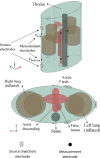Electrode Positioning to Investigate the Changes of the Thoracic Bioimpedance Caused by Aortic Dissection - A Simulation Study
- PMID: 33584902
- PMCID: PMC7531103
- DOI: 10.2478/joeb-2020-0007
Electrode Positioning to Investigate the Changes of the Thoracic Bioimpedance Caused by Aortic Dissection - A Simulation Study
Abstract
Impedance cardiography (ICG) is a non-invasive method to evaluate several cardiodynamic parameters by measuring the cardiac-synchronous changes in the dynamic transthoracic electrical impedance. ICG allows us to identify and quantify conductivity changes inside the thorax by measuring the impedance on the thorax during a cardiac cycle. Pathologic changes in the aorta, like aortic dissection, will alter the aortic shape as well as the blood flow and consequently, the impedance cardiogram. This fact distorts the evaluated cardiodynamic parameters, but it could lead to the possibility to identify aortic pathology. A 3D numerical simulation model is used to compute the impedance changes on the thorax surface in case of the type B aortic dissection. A sensitivity analysis is applied using this simulation model to investigate the suitability of different electrode configurations considering several patient-specific cases. Results show that the remarkable pathological changes in the aorta caused by aortic dissection alters the impedance cardiogram significantly.
Keywords: Aortic dissection; impedance cardiography; numerical simulation; sensitivity analysis.
© 2020 V. Badeli et al., published by Sciendo.
Conflict of interest statement
Conflict of interest Authors state no conflict of interest.
Figures














Similar articles
-
Monitoring of false lumen thrombosis in type B aortic dissection by impedance cardiography - A multiphysics simulation study.Int J Numer Method Biomed Eng. 2023 Feb;39(2):e3669. doi: 10.1002/cnm.3669. Epub 2022 Dec 16. Int J Numer Method Biomed Eng. 2023. PMID: 36507557
-
Computational modelling of blood-flow-induced changes in blood electrical conductivity and its contribution to the impedance cardiogram.Physiol Meas. 2010 Jan;31(1):13-33. doi: 10.1088/0967-3334/31/1/002. Epub 2009 Nov 26. Physiol Meas. 2010. PMID: 19940342
-
Influence of physiological sources on the impedance cardiogram analyzed using 4D FEM simulations.Physiol Meas. 2014 Jul;35(7):1451-68. doi: 10.1088/0967-3334/35/7/1451. Epub 2014 Jun 5. Physiol Meas. 2014. PMID: 24901446
-
[Impedance cardiography--non-invasive measurement of central hemodynamic data].Ugeskr Laeger. 1992 Jan 27;154(5):255-60. Ugeskr Laeger. 1992. PMID: 1736457 Review. Danish.
-
Impedance cardiography for cardiac output estimation in pacemaker patients: review of the literature.Pacing Clin Electrophysiol. 1993 Jul;16(7 Pt 1):1412-22. doi: 10.1111/j.1540-8159.1993.tb01736.x. Pacing Clin Electrophysiol. 1993. PMID: 7689207 Review.
Cited by
-
Cross-Entropy Learning for Aortic Pathology Classification of Artificial Multi-Sensor Impedance Cardiography Signals.Entropy (Basel). 2021 Dec 10;23(12):1661. doi: 10.3390/e23121661. Entropy (Basel). 2021. PMID: 34945967 Free PMC article.
-
DEIT-Based Bone Position and Orientation Estimation for Robotic Support in Total Knee Arthroplasty-A Computational Feasibility Study.Sensors (Basel). 2024 Aug 14;24(16):5269. doi: 10.3390/s24165269. Sensors (Basel). 2024. PMID: 39204964 Free PMC article.
-
The effect of maxillary molar distalization with clear aligner: a 4D finite-element study with staging simulation.Prog Orthod. 2023 May 15;24(1):16. doi: 10.1186/s40510-023-00468-1. Prog Orthod. 2023. PMID: 37183221 Free PMC article.
-
Modeling Anisotropic Electrical Conductivity of Blood: Translating Microscale Effects of Red Blood Cell Motion into a Macroscale Property of Blood.Bioengineering (Basel). 2024 Feb 1;11(2):147. doi: 10.3390/bioengineering11020147. Bioengineering (Basel). 2024. PMID: 38391633 Free PMC article.
References
-
- Khan IA, Nair CK. Clinical, diagnostic and management perspectives of aortic dissection. Elsevier Chest. 2002;122(1):311–28. https://doi.org/10.1378/chest.122.1.311 . - PubMed
-
- Heuser J. Distributed under a CC-BY-SA-3.0 license Wikimedia Commons. 2016.
-
- Patchett N. Distributed under a CC BY-SA 4.0 license. 2015. Wikimedia Commons.
-
- Altamirano-Diaz L, Welisch E, Dempsey AA, Park TS, Grattan M, Norozi K. Non-invasive measurement of cardiac output in children with repaired coarctation of the aorta using electrical cardiometry compared to transthoracic Doppler echocardiography. Physiol Meas. 2018;39(5):055003. 17; https://doi.org/10.1088/1361-6579/aac02b . - PubMed
-
- Reinbacher-Köstinger A, Badeli V, Biro O, Magele C. Numerical simulation of conductivity changes in the human thorax caused by aortic dissection. IEEE Trans. Magnetic. 2019;55(6):5100304. https://doi.org/10.1109/tmag.2019.2895418 .
LinkOut - more resources
Full Text Sources
Other Literature Sources
